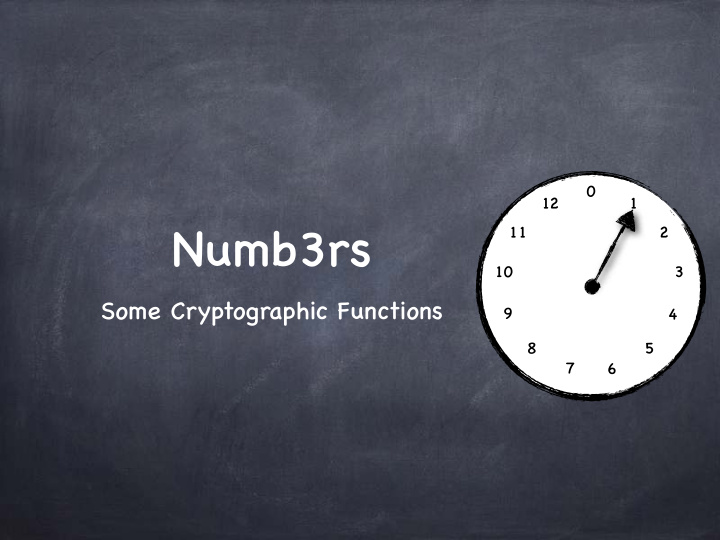



0 12 1 Numb3rs 11 2 10 3 Some Cryptographic Functions 9 4 8 5 7 6
A Word on Efficiency Very huge numbers have very short representation Take a 256 bit integer, 11…1 = 2 256 -1 Can a computer just count up to this number? No. Not even if it runs - at the frequency of molecular vibrations (10 14 Hz) - for the entire estimated lifetime of the universe (< 10 18 s) What if you recruited every atom in the earth ( ≈ 10 50 ) to do the same? OK, but still will get only to 10 82 ≈ 2 272 . And even if you recruited every elementary particle in the known universe ( ≈ 10 80 ), only up to 10 112 ≈ 2 372 The whole known universe can’ t count up to a 400-bit number!
A Word on Efficiency The whole known universe can’ t count up to a 400-bit number! But we can quickly add, multiply, divide and exponentiate much larger numbers. Even find gcd for them! Roughly, can “compute on” n-bit numbers in n or n 2 steps But not if you try an algorithm based on counting through all the numbers! That takes 2 n steps. (e.g., exponentiation using naïve repeated multiplication) For some problems involving n-bit numbers we don’ t know algorithms that do much better than 2 n , 2 n/2 etc. We believe for some such problems no better algorithms exist! (Currently, only a belief based on failure to discover better algorithms) Such hardness forms the basis of much of modern cryptography
Cryptography from Z * m Trapdoor One-Way Permutation Often a building block in “public-key encryption” Roughly, it’ s a bijection (permutation) that is easy to compute but hard to invert (one-way); but while defining the function you can setup a secret (trapdoor) that makes it easy to invert too Will see two trapdoor one-way permutation candidates, based on modular exponentiation Rabin’ s function Rivest-Shamir-Adleman (RSA) function Both use a modulus of the form m=pq (p,q large primes) Breaking would be easy if m were prime Also can be broken (using CRT) if factors of m known.
R e c a Square-roots in QR * l l p 1 8 7 In Z* p √ (x 2 ) = ±x 9 5 Z* 11 If (p-1)/2 odd, squaring is a permutation in QR* p 6 2 4 3 This permutation is easy to compute both ways 10 In fact √ z = z (p+1)/ 4 ∈ QR* p (because (p+1)/2 even) Say z = x 2 ∈ QR* p . (z (p+1)/ 4 ) 2 = x (p+1) = x 2 Rabin function defined in QR * m and relies on keeping the factorisation of m=pq hidden
Rabin Function Trapdoor One-Way Permutation Candidate Rabin m (x) = x 2 (in QR* m ) with m=pq (p,q random k-bit primes for, say k=2000) If p, q ≡ 3 (mod 4), then in QR * m this function i.e., (p-1)/2 and (q-1)/2 are odd Is a permutation Has a trapdoor for inverting, namely (p,q) By CRT: Let x ↦ (a,b). Then √ x ↦ ( √ a, √ b) = (a (p+1)/ 4 , b (q+1)/ 4 ) Conjectured to be a one-way function
RSA Function Trapdoor One-Way Permutation Candidate RSA m,e (x) = x e (in Z m ) where m=pq (p,q random k-bit primes for, say k=2000) and gcd(e, φ (m)) = 1 (i.e., e ∈ Z* φ (m) ) A commonly used version (for efficiency) fixes e=3 RSA m,e is a permutation with a trapdoor (namely d) In fact, there exists d s.t. RSA m,d is the inverse of RSA m,e d = e -1 in Z* φ (m) ⇒ x ed = x in Z m For x ∈ Z* m , by Euler’ s Totient Theorem x ed-1 = 1 For all x ∈ Z m , by CRT (since m=pq) Conjectured to be a one-way function
Recommend
More recommend